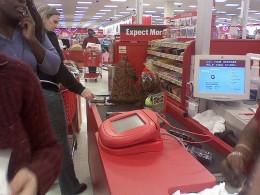The End of Signatures at the Checkout Counter

I have three different signatures that I use:
• My full name in legible cursive, which I use when signing personal checks and legal documents
• An abbreviated version of my name, which I use when signing anything digitally
• A scribble, which I use when I’m signing receipts for various merchants
This all seems calculated, as if I could dispute a forged check by arguing, “That couldn’t be my signature! I only sign in careful cursive!” And now you all know.
And it doesn’t matter that you all know. Because back when we first started using personal checks, banks had rooms full of people whose job was to verify signatures on checks with ones they had on file. That’s not the case anymore. I’ve always thought that those jobs were replaced by computers, but according to a story by NPR: “no one regularly looks at what you sign on the bottom of a check. That’s true for credit cards, too. Companies electronically store their credit card signatures, but accessing them is not a regular occurrence, according to Carolyn Balfany of MasterCard.”
This makes sense — we often sign digitally on card readers using an electronic pen, and those swoops that are suppose to represent my name rarely look like the swoops I make when I’m asked to sign a paper receipt with real ink. This is why no one says anything if you scribble your name or draw a tree when you pay with a credit card; it all gets filed until the day you say, “nope, I didn’t buy this,” and then the receipt and signature gets pulled up to jog your memory.
Stores have also been using systems like Mastercard QPS, which allows merchants to cut down on paperwork and customers to quickly complete a transaction for low-dollar purchases — which explains why you don’t always have to provide a signature when paying with a credit card (merchants using QPS require signatures for transactions above $50).
Another thing I learned over the course of writing this post about signatures: If your card has a MasterCard or Visa logo, a merchant can technically refuse to accept it if it’s unsigned. I’ve always left my cards unsigned with the hopes that I would be asked for I.D. Also learned: Both MasterCard and Visa prohibit stores from requiring an ID from you for you to use a card (“’They can ask for that ID, but you can refuse to show the ID and they still must accept the card,’ says Paul Stephens, director of policy and advocacy at the Privacy Rights Clearinghouse, a nonprofit that advocates for consumer privacy rights.” WHAT.)
But the thing that may kill our signatures for good? Our smartphones. Apple’s new tap-and-go payments system on the iPhone will require a verification that’ll be harder to forge: a thumbprint.
Photo: Consumerist
Support The Billfold
The Billfold continues to exist thanks to support from our readers. Help us continue to do our work by making a monthly pledge on Patreon or a one-time-only contribution through PayPal.
Comments